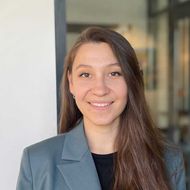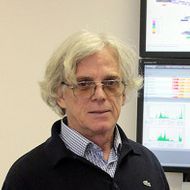Operation of Cellular Networks Found Similar to Bacteria Growth in Petri Dish

Scientists at HSE University have discovered an approach to analysing mobile communication quality by applying the principles of surface physics
Scientists at the HSE Laboratory for Computational Physics have developed a new model for analysing communication networks that can significantly enhance the speed of mobile communications. To achieve this, the researchers used computational physics methods and phase transition models. It turns out that the functioning of cellular networks is in many ways similar to the growth of surfaces in physics. The study was performed using the HPC cHARISMa cluster at HSE University. The study findings have been published in Frontiers in Physics.
Mobile networks enable making calls, sending messages, and using the internet. However, for these networks to function smoothly, it is essential to be able to simulate their operation. Simulations help predict how a network will behave in various situations, including extreme conditions, and identify areas for improvement.
One of the key tools for studying mobile networks is parallel discrete-event simulation (PDES). This method is based on splitting a system into numerous subsystems to enable parallel modelling of various processes. Each of these subsystems has its own local virtual time, which does not align with the actual time. When the local times significantly diverge from each other, leading to process desynchronisation, the network may experience slower operation or errors. Lev Shchur and Liliia Zhukova, scientists at HSE MIEM, studied the evolution of local virtual time profiles in a cellular communication model and discovered similarities with the surface growth processes in physics.

Associate Professor, School of Applied Mathematics, HSE Tikhonov Moscow Institute of Electronics and Mathematics
After conducting a thorough analysis of the processes, we observed similarities between changes in local time in cellular communication modelling and alterations in a surface profile as it grows, eg through spray application, as the time only progresses forward. Surface physics is a well-established field with equations that facilitate analysis and modelling of various processes. We have transferred knowledge from this domain to computing technologies and constructed a model simulating the evolution of local virtual time profiles.
By comparing their findings with a model of a real mobile network, the scientists have found that the proposed method enables accurate prediction of critical moments when the network's performance may deteriorate, so that issues can be addressed proactively, leading to improved network operation.

Head, Laboratory for Computational Physics, HSE Tikhonov Moscow Institute of Electronics and Mathematics
With the help of computational physics algorithms, it becomes possible to determine the moment when local time ceases to progress, referred to in physics as the phase transition point. We can describe the events occurring around it and anticipate potential communication disruptions or alterations in load distribution at a cellular communication station. With this model, we can provide the industry with better tools for planning, constructing, and operating mobile networks.
The researchers emphasise that understanding the mechanics of parallel computing in actual high-load networks will facilitate faster and more efficient simulation of mobile networks and other systems employing similar calculations across various domains such as engineering, computer science, economics, and transportation.
See also:
HSE Psycholinguists Launch Digital Tool to Spot Dyslexia in Children
Specialists from HSE University's Centre for Language and Brain have introduced LexiMetr, a new digital tool for diagnosing dyslexia in primary school students. This is the first standardised application in Russia that enables fast and reliable assessment of children’s reading skills to identify dyslexia or the risk of developing it. The application is available on the RuStore platform and runs on Android tablets.
Physicists Propose New Mechanism to Enhance Superconductivity with 'Quantum Glue'
A team of researchers, including scientists from HSE MIEM, has demonstrated that defects in a material can enhance, rather than hinder, superconductivity. This occurs through interaction between defective and cleaner regions, which creates a 'quantum glue'—a uniform component that binds distinct superconducting regions into a single network. Calculations confirm that this mechanism could aid in developing superconductors that operate at higher temperatures. The study has been published in Communications Physics.
Neural Network Trained to Predict Crises in Russian Stock Market
Economists from HSE University have developed a neural network model that can predict the onset of a short-term stock market crisis with over 83% accuracy, one day in advance. The model performs well even on complex, imbalanced data and incorporates not only economic indicators but also investor sentiment. The paper by Tamara Teplova, Maksim Fayzulin, and Aleksei Kurkin from the Centre for Financial Research and Data Analytics at the HSE Faculty of Economic Sciences has been published in Socio-Economic Planning Sciences.
'Even among Geniuses, Luck Plays a Role in Winning a Nobel Prize'
Denis Bodrov studies particle physics and works at one of the four electron–positron colliders in the world. In this interview with the HSE Young Scientists project, he talks about his efforts to go beyond the Standard Model, discusses tau leptons, and shares his affection for Moscow.
Larger Groups of Students Use AI More Effectively in Learning
Researchers at the Institute of Education and the Faculty of Economic Sciences at HSE University have studied what factors determine the success of student group projects when they are completed with the help of artificial intelligence (AI). Their findings suggest that, in addition to the knowledge level of the team members, the size of the group also plays a significant role—the larger it is, the more efficient the process becomes. The study was published in Innovations in Education and Teaching International.
New Models for Studying Diseases: From Petri Dishes to Organs-on-a-Chip
Biologists from HSE University, in collaboration with researchers from the Kulakov National Medical Research Centre for Obstetrics, Gynecology, and Perinatology, have used advanced microfluidic technologies to study preeclampsia—one of the most dangerous pregnancy complications, posing serious risks to the life and health of both mother and child. In a paper published in BioChip Journal, the researchers review modern cellular models—including advanced placenta-on-a-chip technologies—that offer deeper insights into the mechanisms of the disorder and support the development of effective treatments.
Using Two Cryptocurrencies Enhances Volatility Forecasting
Researchers from the HSE Faculty of Economic Sciences have found that Bitcoin price volatility can be effectively predicted using Ethereum, the second-most popular cryptocurrency. Incorporating Ethereum into a predictive model reduces the forecast error to 23%, outperforming neural networks and other complex algorithms. The article has been published in Applied Econometrics.
Administrative Staff Are Crucial to University Efficiency—But Only in Teaching-Oriented Institutions
An international team of researchers, including scholars from HSE University, has analysed how the number of non-academic staff affects a university’s performance. The study found that the outcome depends on the institution’s profile: in research universities, the share of administrative and support staff has no effect on efficiency, whereas in teaching-oriented universities, there is a positive correlation. The findings have been published in Applied Economics.
Physicists at HSE University Reveal How Vortices Behave in Two-Dimensional Turbulence
Researchers from the Landau Institute for Theoretical Physics of the Russian Academy of Sciences and the HSE University's Faculty of Physics have discovered how external forces affect the behaviour of turbulent flows. The scientists showed that even a small external torque can stabilise the system and extend the lifetime of large vortices. These findings may improve the accuracy of models of atmospheric and oceanic circulation. The paper has been published in Physics of Fluids.
Solvent Instead of Toxic Reagents: Chemists Develop Environmentally Friendly Method for Synthesising Aniline Derivatives
An international team of researchers, including chemists from HSE University and the A.N. Nesmeyanov Institute of Organoelement Compounds of the Russian Academy of Sciences (INEOS RAS), has developed a new method for synthesising aniline derivatives—compounds widely used in the production of medicines, dyes, and electronic materials. Instead of relying on toxic and expensive reagents, they proposed using tetrahydrofuran, which can be derived from renewable raw materials. The reaction was carried out in the presence of readily available cobalt salts and syngas. This approach reduces hazardous waste and simplifies the production process, making it more environmentally friendly. The study has been published in ChemSusChem.


